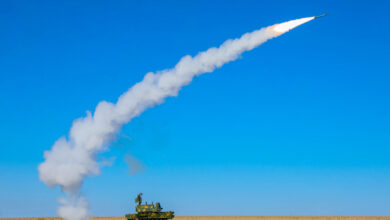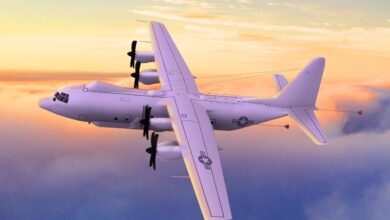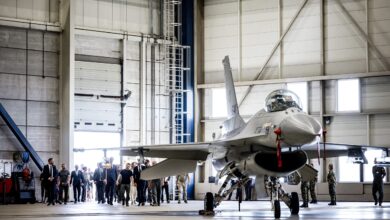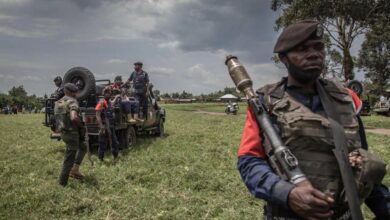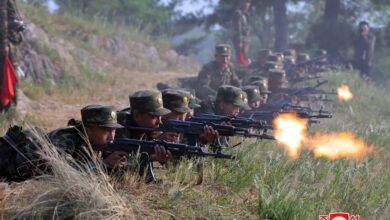Philippines military photos show children among ISIS foreign fighters killed in Marawi
KUALA LUMPUR, Malaysia – Child soldiers were among 32 foreign militants who were killed during the battle of Marawi last year, images released to a Filipino terrorism expert appear to show.
More than 1,200 people, mostly militants, were killed during the five-month battle between the Armed Forces of the Philippines and militant groups linked to Islamic State in the southern Philippine city of Marawi that ended in October 2017.
The Maute group and Abu Sayyaf effectively held Marawi hostage in their aim to create an Islamic state in Southeast Asia. The battle resulted in the utter destruction of the once-vibrant Islamic City of Marawi, the only one so designated in the Philippines.
During and after the battle, reports emerged about child soldiers fighting alongside the militants.
Early in the fighting, unsuspecting Philippine troops were taken by surprise by attacks from children they initially thought were innocent.
The militants in Marawi were helped by foreign fighters, mainly from Indonesia and Malaysia, although some reportedly came from Yemen, Saudi Arabia and Chechnya.
Partial list of ISIS foreign fighters revealed
It is unclear how many foreign fighters were involved in the Marawi battle, but a Filipino terrorism expert has revealed a “semi-official” and partially complete list of foreign militants, including apparent children, killed in Marawi.
Citing information on a slide provided to him by the Armed Forces of the Philippines (AFP), Chairman of the Board of the Philippine Institute for Peace, Violence and Terrorism Research Rommel Banlaoi told The Defense Post that 32 foreign fighters had been neutralized in Marawi.

Banlaoi presented that information at a security symposium in Kuala Lumpur last month. Despite the wide media reporting of the event, there has been no coverage of Banlaoi’s presentation.
While mentioning the 32 foreign militants killed, the slide lists only 16 of them, and it does not include their ages, nationalities or other information such as how and when they were killed.
Malaysian minors in the Philippines
Two of those listed – Jamil and Akmad Bin Amin Baco – appear to be minors. The latter has been confirmed to be a teenager from the Malaysian Borneo state of Sabah.
The exploits of the Malaysian boy Akmad, whose real name was Ahmad Malqasi, were detailed by this writer last year in a report for Free Malaysia Today.
Akmad Bin Amin Baco (Akmad, son of Amin Baco) was 11 or 12 years old when he left his home in the Sabah district of Tawau and traveled to the southern part of the neighboring Philippines as early as 2015, despite heavy security.
According to Lordvin Acopio, a former hostage held by militant groups in Marawi, Akmad and his father Amin Baco often fought together against Philippine troops on the front line.
Malaysian Inspector-General of Police Fuzi Harun confirmed to this writer that Amin Baco, a former member of the outlawed group Darul Islam Sabah who had been hiding in the southern Philippines for years, returned home to Tawau to fetch Ahmad Malqasi before taking him to Mindanao in 2015 or 2016.
Jamil’s age and nationality are not known but the image strongly suggests he was a boy.
The apparent adult foreign fighters listed in the slide are Dr. Mahmud Ahmad, Muhammad Joraimee Awang Raimee, Jabir, Abu Ayas, Ali Al Amin (also known as Paalam or Abu Faisal), Abu Muslim, Al Ikhwan Yushel, Abu Jais, Yoki Patrama Windyarto (Mohajir), Abu Ezza/Aisa, Salem, Khalid and Wahed.
Banlaoi hinted that he might have a complete list of the 32 foreign fighters, possibly containing more children. When asked for details on the remaining 16, he said: “That’s the only slide I’m authorized to use in the public domain.”
A Malaysian security source told The Defense Post no lists of foreign fighters killed in Marawi had been made available before.
“It could be the first such a total list issued by the Philippine armed forces and made publicly available though in a roundabout manner,” said the source, who asked not to be named.
The Defense Post asked the Malaysian police for comment but has yet to receive a response. But police repeatedly said last year that they themselves had not yet received official confirmation from the Philippines on many issues, including the deaths of Malaysian militants.
In January, the Manila Times reported that thousands of children, including stateless minors from Sabah, crossed the maritime border and joined militant groups in the southern Philippines. Ramli Din, then the chief of police in Sabah, later dismissed the report.
Munira Mustaffa, a Malaysian terrorism researcher at American University in Washington D.C., is skeptical about the report of stateless Sabah children, who often have Filipino ties, fighting in Marawi.
“[Philippine media] have the tendency of assuming every undocumented person [in the southern region of Mindanao] to be from Sabah. The other possibility is that they could just be that – assumptions and/or exaggerations,” she told The Defense Post.
Cubs of the Caliphate
Munira said one of the reasons child fighters are recruited is to encourage supporters or affiliates, both local and overseas, to send their children to be conditioned.
“Perhaps they are trying to copy the Syria/Iraq IS cub model, or even the [Indonesian] Jemaah Islamiyah model,” she said. “I think the IS cub model is the stronger likelihood, considering their network, ideology and affiliations.”
Meanwhile, the militant groups employed various methods of recruiting local children, such as by bribing parents or kidnapping the youngsters from their homes.
Terrorism analyst Pawel Wojcik said children are important for every Islamic State affiliate because of the potential to turn them into hardcore and jihad-dedicated warriors.
“This is similar to the ‘Cubs of the Khilafah’ model we witnessed in the Middle East in the last few years. In southern Philippines, most of them are relatives of the actual jihadists, but when it comes to Maguindanao province, the ISEA [Islamic State-East Asia] emir there, Abu Dar, has been recruiting children to fight among IS cadres, paying their parents monthly salaries,” Wojcik said.
“So, the most expanded youth strategy seems to have been getting implemented across the Abu Dar and Abu Turayfie’s [leader of the IS affiliate Bangsamoro Islamic Freedom Fighters] region of influence, namely Lanao del Sur/Norte, Cotabato and General Santos.”

Wojcik supplied The Defense Post with images of apparent child fighters obtained from Philippine IS online communication channels.
He said two of the images appear to show show children in Sulu and Basilan, site of a suicide bombing at a military checkpoint on July 31, while the rest show children in the Marawi battle.
One of the images shows militants praying in a jungle area, and was circulated after the Basilan bombing. Experts and analysts have speculated that a boy and a man in the photo seem to have Middle East physical appearances, although that does not necessarily mean they are Middle Eastern.

Soon after the bombing, ISIS claimed through their Amaq news agency that a Moroccan militant, Abu Khatir Al-Maghribi, carried out the suicide operation on the Philippine army post, and released a photo.
The AFP initially denied that a foreigner was involved in the Basilan bombing but defense secretary Delfin Lorenzana later conceded that a Moroccan allied with the Abu Sayyaf group was most likely behind the attack.

The Defense Post has contacted the AFP for information on the 16 named in the slide and on the other 16 militants whose details are missing, but has not received a response.
Two of those listed – Dr. Mahmud Ahmad and Muhammad Joraimee – were Malaysians, but the nationalities of the others have not been established.
“Most of these names are aliases or only first names,” said Banlaoi, who is also President of the Center for Intelligence and National Security Studies.
Philippine suppression of information on jihadis
American University’s Munira said the Philippine military’s apparent lack of transparency could be due to the possibility that they are trying to protect their sources or themselves.
“Or they are trying to avoid any domestic or international security mishaps that might risk making them looking weak or ineffective,” she said.
“I won’t dispute these possibilities, considering IS/ISEA have been working on the narrative of turning southern Philippines [into a hub] and drumming up operations. The AFP might not want this to be out in the open for several security factors.”
“They have been suppressing news on the ISEA jihadi movement before this until the Marawi siege blew up. I’m aware that there are people/critics who hold the assumptions that AFP are being in denial or covering up their failures. Be mindful that we should also account for possible intelligence/domestic security reasons that’s not being explicitly said.”
Munira also said there could be some on-the-ground issues, including tensions between the smaller clans and ethnic groups and the suspicion they have towards the central Manila government.
“From what I could recall, the AFP have been working at trying to foster better community relations, and there are a lot of challenges with regards to this. I mean, there are local warlords that could jeopardise their efforts,” she said.
“So maybe the AFP is probably being over-cautious with information flow, hence the extreme compartmentalization.”
Misinformation and intelligence failures: How the Philippines underestimates ISIS




